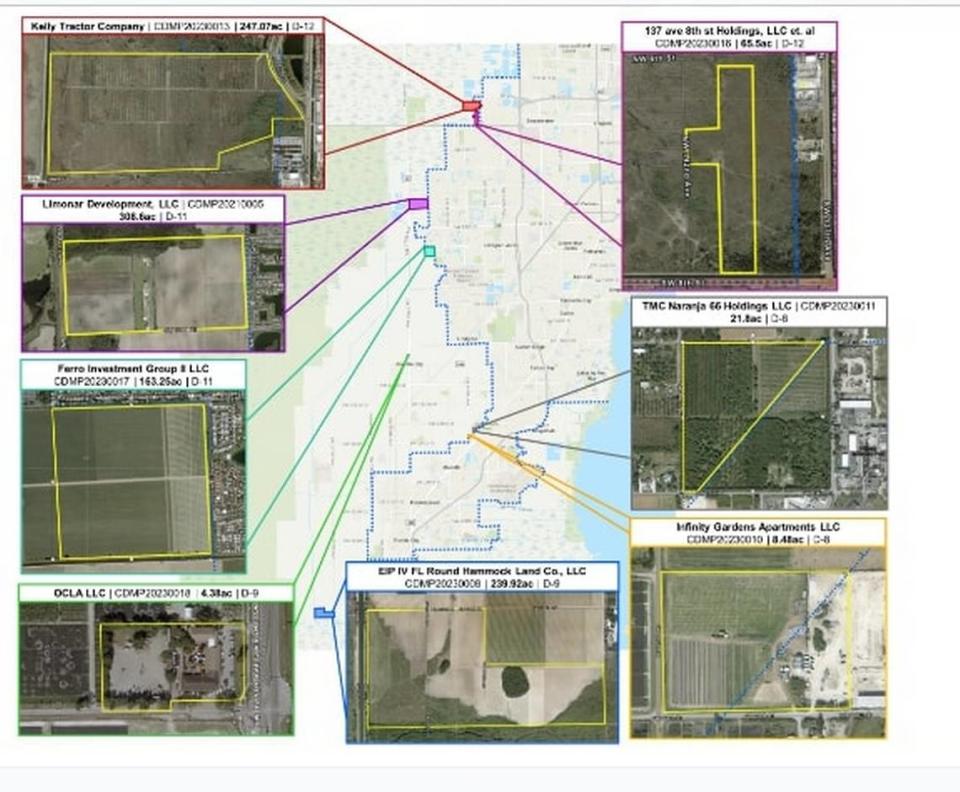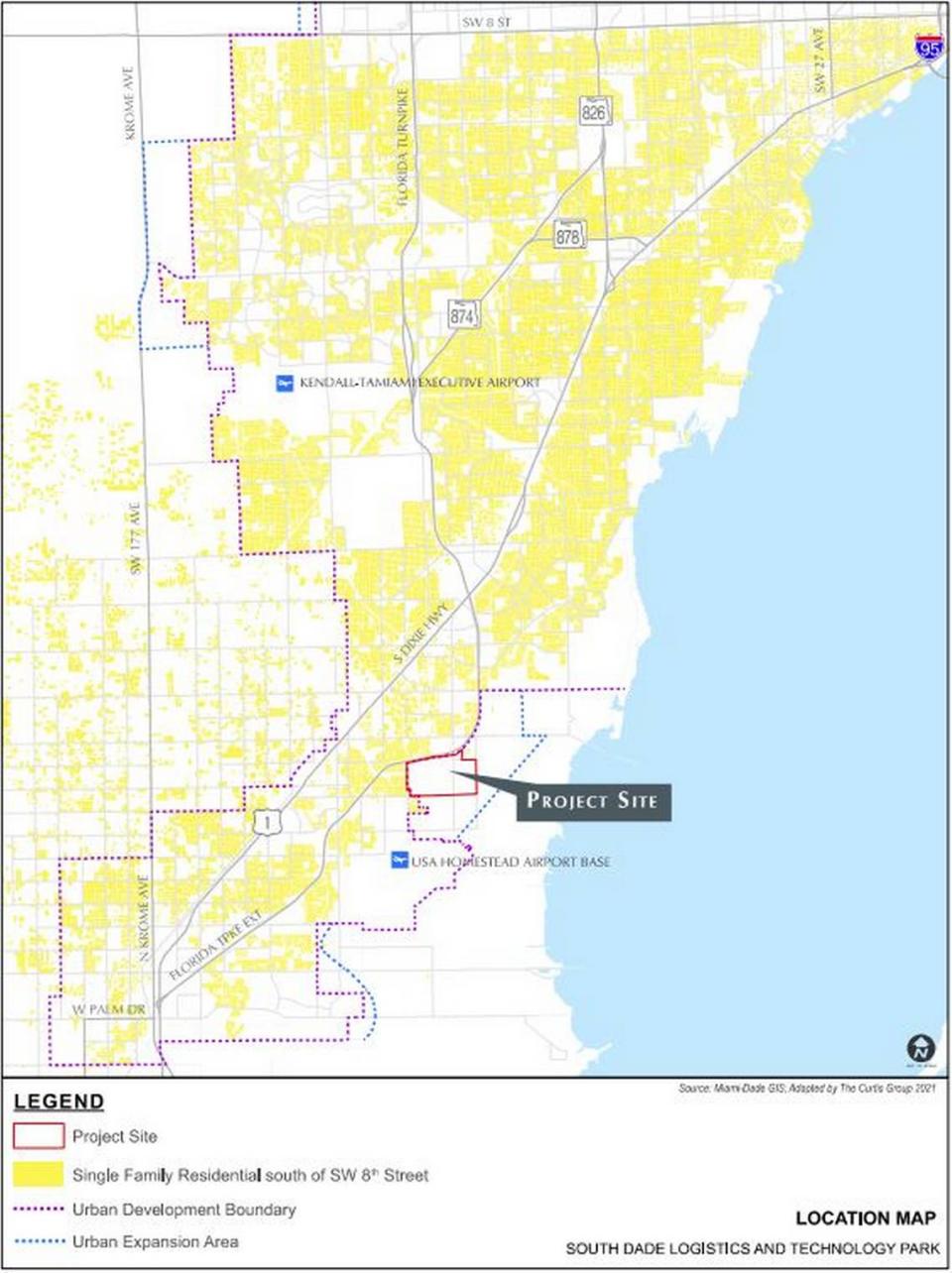‘Flood gates are opened.’ More projects want approval outside Miami-Dade development zone
A year after Miami-Dade commissioners granted rare approval for a large project beyond the county’s conservation buffer, there’s a batch of proposals eager to give them the chance to do it again.
This year, developers filed seven applications to build beyond the current Urban Development Boundary (UDB), where the suburbs end and construction is limited.
The boundary is designed to create a buffer between large residential and commercial projects and two of Miami-Dade’s most sensitive areas: the rural belt of farmland that forms the heart of the county’s agriculture industry, and the Everglades, well fields and wetlands that support its ecosystem and protect its drinking water.
Environmental groups say they’re concerned about the spike in UDB applications a year after Miami-Dade commissioners approved the first UDB change in a decade.
READ MORE: Miami-Dade commission OKs project that critics say threatens Everglades restoration
“The flood gates are opened,” said Laura Reynolds, director of the Hold the Line Coalition, an umbrella group of conservation organizations and others that typically leads the charge against proposals to expand the UDB.
While Miami-Dade doesn’t have a yearly tally on applications for construction outside the UDB, the Department of Regulatory and Economic Resources pointed to the 10 applications filed in 2005 as the last time there were this many UDB requests in the pipeline.
Reynolds noted the application push follows passage of state legislation that will make it harder for non-profits to challenge future UDB expansions in court. Senate Bill 540, signed into law in May by Gov. Ron DeSantis, allows developers to collect attorney costs from groups who mount unsuccessful legal challenges of a county’s Comprehensive Development Master Plan. That’s part of county law that contains land-use rules, including the location of the UDB.
Only three of the seven latest Miami-Dade applications request altering the UDB to bring more acreage into the urban area. That was the step that the South Dade Logistics and Technology commercial complex won with a one-vote margin before the commission in November 2022, followed by a successful override vote after Mayor Daniella Levine Cava vetoed the board’s action. Adding nearly 400 acres to the urban zone was the first UDB move since 2013, and the project is currently tied up in legal challenges.

The projects that don’t need boundary changes still require a commission vote to change the rules governing construction beyond the UDB. Those rules are part of the Comprehensive Development Master Plan, and changing them requires two commission votes: the first to send the proposed alterations to the state for review, and the second to grant final local approval.
Here’s a look at the 2023 UDB applications moving through the legislative pipeline:
From farmland to wetlands
Developer Ecosystem Investment Partners wants county permission to convert into wetlands the farmland on a 240 -acre parcel east of Southwest 227th Avenue and just south of 400th Street. That conversion would allow the owners, listed as pension funds in county documents, to generate revenue by selling “mitigation credits” to developers looking to fill in wetlands elsewhere in Florida under a state program designed to generate conservation dollars.
“You basically preserve this land into perpetuity,” said Hugo Arza, the lawyer representing the project known as EIP IV FL Round Hammock Land.
The cost would be active farmland at a time when concern is growing that Miami-Dade’s agriculture industry will lose too much ground to development to remain healthy. A county study released earlier this year said Miami-Dade will need at least 64,800 acres in 2030, roughly 7% less than the existing 70,000 acres of farmland.
County planning staff recommend commissioners transmit the application to Tallahassee for review, a move that would give developers the first of two votes needed for approval.
Two apartment complexes
The Infinity Gardens mixed-used complex would be built on land that’s split by the UDB north of Southwest 260th Street and east of Southwest 147th Avenue. For the 14-acre site, developer Brandon Shpirt needs the UDB to expand to absorb an additional eight acres, according to application filings.
Along with having a development site that’s already partially inside the UDB, Shpirt’s team is pitching the property as a natural area for growth because of its proximity to rapid transit.
The site sits half a mile from the station under construction at Southwest 264th Street for the county’s rapid-transit bus line to operate on the South Dade Transitway. It is also in the Redland agricultural region south of Eureka Drive (Southwest 184th Street), an area that county policy says should not be considered for UDB expansions.
County planning staff offered a mixed review of the project in an Oct. 30 report. They urged commissioners to reject parts of the application that would change county rules to make it easier for similar projects to be approved on farmland. But the staff also said it’s worthwhile to send the application to Tallahassee for review, given its proximity to a major transit line and its proximity to a designated urban zone with higher density in the Naranja area .
Nearby, a different development group needs a similar approval for a mixed-used project on land that’s near a transit line and only partially outside the UDB.
The Naranja 66 project would be built on an 71-acre site off of Southwest 142nd Avenue and south of 252nd Street. Developers need 20 acres of farmland brought into the urban area. The plan is to build a residential complex with 630 residential units, mostly apartments with some townhomes, and about 6,400 square feet of retail space.
The South Dade busway is less than half a mile away, and developers are pitching the project as a way to bring more workforce housing near a major transit corridor. While county planning staff noted forecasts show there’s enough land inside the UDB to create apartments closer to employment centers through 2040, they’re recommending commissioners transmit the application for state review to consider whether homes near transit justify expanding the UDB for the project.
Two more trucking facilities
Two applications don’t want to move the UDB but want permission to build commercial operations outside the urban area that cater to large trucks and heavy equipment.
Kelly Tractor Co., the family-owned construction equipment supplier with headquarters in Doral, wants to move its main operations to a larger campus outside the UDB. The family owns the 246-acre site west of Northwest 137th Avenue and next to where State Road 836 ends. Currently used to grow palm trees, the site would become a depot for Kelly’s heavy construction equipment, plus office space and a training center.
The company says about 500 additional jobs would come with the new headquarters for the statewide operation. The Hold the Line group said the project’s adverse impact would be “very high” in a recent analysis, citing environmentally sensitive lands in the proposed site.
Nearby, there’s a plan for another cargo complex for trucks. Developer 137 Ave 8th St. Holdings wants to build a 69-acre center with parking for at least 800 tractor trailers that would either start or end their routes at the facility. The site, north of Southwest Eighth Street and west of Northwest 137th Avenue, would also have 90,000 square feet of storage, cargo facilities and space to store shipping containers. There would also be 30,000 square feet of retail and medical facilities for truckers.
Commissioners approved a similar facility outside the UDB earlier in the year.
Jeffrey Bercow, a lawyer representing the 137 Ave group, said the project is needed to meet the high demand for truck parking and eliminate the need for truckers using the complex “to venture into more populated areas of the County with their rigs to obtain basic goods and services.”
Reynolds, from Hold the Line, says it’s too early to consider a second trucking complex outside the UDB. “We’ve already approved something like this to deal with the need for truck parking,” she said. “I think we need to see if that satisfies the need before we building something else.”
County staff have not yet issued recommendations for the applications.
Request for thousands of new homes
The Portofino project by Ferro Investment Group would convert more than 160 acres of farmland into a new community, with single-family houses, townhomes and apartments, plus roughly 200,000 square feet of retail, restaurants and offices. There would be more than 1,600 residential units in all. To build the project west of Southwest 162nd Avenue and south of Southwest 104th Street, developers would need the full 163 acres moved into the urban area.
The site sits in a zone designated for future UDB expansion, once county planners conclude builders have used up the land supply for housing inside the urban area.. Though there isn’t a planning recommendation for this project yet, county planners say there are still enough housing sites in the urban area to accommodate growth through 2040. Hold the Line rates the project as having “high” adverse impact for the loss of farmland and for environmental issues with the site.
Rural shopping center wants a grocery store
Ocla LLC doesn’t need a UDB expansion for its application. It needs permission to expand an existing commercial operation on Krome Avenue that has been in business since the early 1970s, before the UDB formally became part of the county’s land plan in the 1980s. Now owners want permission to build what’s described as a grocery store next to a two-acre site that already has stores at 19100 SW 177th Avenue.
There is not yet a recommendation from county staff on the project. In the Hold the Line analysis, the project is listed as having a “low” adverse impact.
“A lot of people already live in this area,” said Ben Fernandez, the lawyer representing the developer. “They’re driving long distances within the Urban Development Boundary to buy their groceries.”


